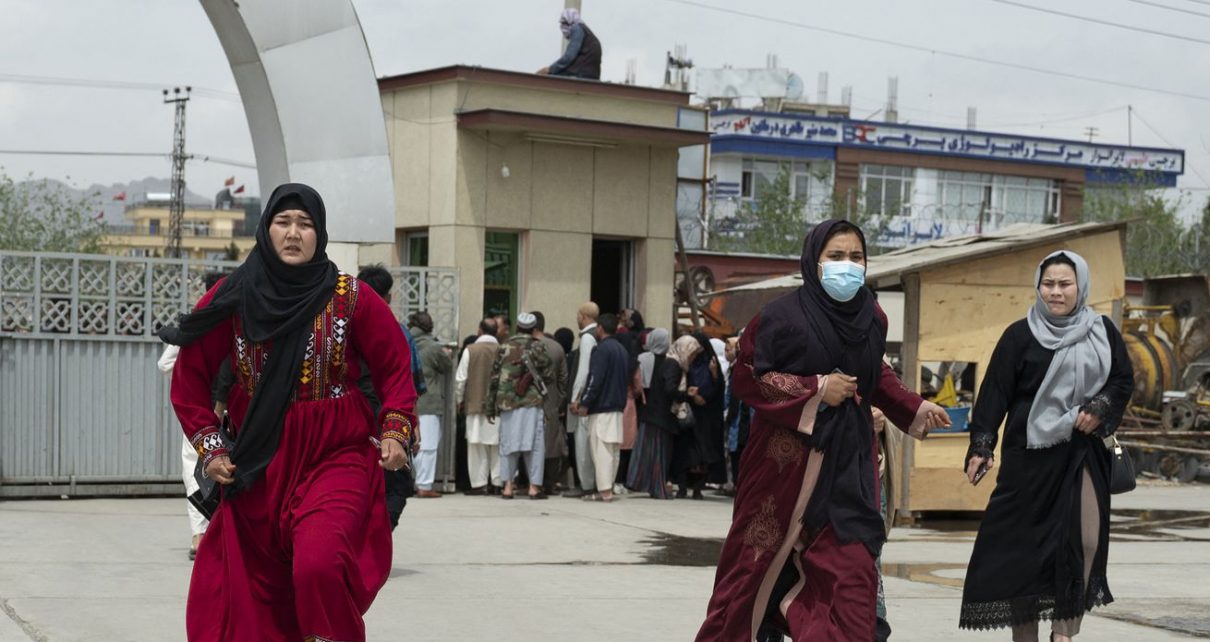
A week of deadly attacks targeted Afghan minorities — and the Taliban has done little to respond
A spate of attacks this week all over Afghanistan killed at least 77 people, including children. At least one — and likely most — of the attacks were carried out by ISIS Khorasan (ISIS-K), the Islamic State affiliate active mostly in Afghanistan and Pakistan. The devastating attacks are further destabilizing a nation already in economic free-fall and further increase doubt that the Taliban can protect the Afghan people — especially minorities — from violence and terror.
The attacks started Tuesday, with double bombings at the Abdul Rahim Shaheed High School and in the vicinity of the Mumtaz Education Center, both in the capital Kabul. There were at least six deaths and 17 injuries at the Abdul Rahim Shaheed High School in the predominantly Shia and Hazara Dasht-e-Barchi neighborhood, Al Jazeera reported Tuesday. While no group has yet claimed responsibility for the attacks, ISIS-K has been known to target Dasht-e-Barchi in the past. Government workers in Kunduz province were targeted this week, as well — an attack for which ISIS-K claimed credit.
Attacks continued Thursday, with a bombing at a Shia mosque in Mazar-e-Sharif, in northern Afghanistan. That attack, which ISIS-K claimed credit for on Friday, killed at least 31 people and injured many more, Pamela Constable reported in the Washington Post Friday. The Associated Press put the number of dead much lower, at 12, in a Saturday report. In a statement on Friday claiming responsibility for the attack, ISIS-K said that the bomb was in a bag that was left in the Seh Doken mosque; it exploded when the mosque was filled with worshippers. “When the mosque was filled with prayers, the explosives were detonated remotely,” the ISIS-K statement claimed, also alleging that 100 worshippers were injured. Around the same time, the New York Times reported Friday, ISIS-K attacked a bus in Kunduz province, killing four and injuring 18.
After the Taliban government announced it had arrested the “mastermind” of the Mazar-e-Sharif bombing in Balkh province on Friday, an explosion at a mosque in Kunduz province killed at least 30, and a mine went off near a market in Kabul, ending the already-devastating week with even more destruction.
It’s unclear if ISIS-K is behind all of the attacks, but this week’s attacks indicate that the Taliban either doesn’t have as much control over the security situation in Afghanistan as leadership had indicated it would after US and NATO forces left the country in August, or isn’t particularly interested in providing protection to minorities. It doesn’t help matters that the country is facing destabilization wrought by economic sanctions against Taliban leaders, coupled with the Taliban’s persecution of women, journalists, human rights workers, and other groups. But the Taliban’s inaction does send a strong message.
That’s likely the intention, though, Faiz Zaland, an academic and political analyst in Kabul, told the Washington Post. “These attackers are trying to build up a momentum of insecurity, to show that even with the Taliban in power, they cannot be stopped,” he said. “They are announcing a spring and summer of destruction.”
Both the Taliban and ISIS-K have attacked minorities
Both the Taliban and ISIS-K are considered Sunni extremist groups, adhering to a strict interpretation of the sect’s ideology which views Shia Muslims as apostates, or nonbelievers. While the Taliban does have a history of targeting Afghanistan’s Shias, the group agreed in the lead-up to its takeover that minorities would be protected under a new Taliban government.
The Hazara, an ethnic minority which mostly practices Shia Islam, has been historically marginalized, with few opportunities for education or employment. They are Afghanistan’s third-largest ethnic group, behind Pashtuns and Tajiks.
But even before the Taliban took over the Afghan government for a second time this past August, there have been a number of attacks on Shias, and specifically Hazaras. Last May, for example, a vicious attack on a girls’ school in a predominantly Hazara section of Kabul killed at least 90; the Taliban denied responsibility for the bombing. But even before the Taliban came back into power, minority groups lacked protection from the government; protection that — despite a history of targeting Shia minorities during its first period of rule in the 1990s — the Taliban said it would provide, particularly following a number of attacks on Hazara communities by ISIS-K.
However, while the Taliban has said it would not interfere with Shia worship and will protect all ethnic groups, the group is responsible for the deaths of dozens of Hazara over the past eight months, as well as mass forced displacements of Hazara people.
Not only is the Taliban government directly threatening Hazara people, it’s either unable or unwilling to protect them and other minorities against the attacks of other groups, namely ISIS-K, Asfandyar Mir, a senior expert at the US Institute of Peace focusing on extremism in Afghanistan and Pakistan, told Vox via email. “When the Taliban are pushed on issues of rights and economic well-being of the Afghan people, they push back by touting their ability to provide security for all Afghans, including minorities,” he said. “Yet under the Taliban, vulnerable minorities — in particular the Hazara — continue to be one of the main targets of violence. This is a source of enormous insecurity and raises questions about the Taliban’s ability to provide security in general and against minorities in particular.”
Though the Taliban has instituted a crackdown of sorts on ISIS-K since coming to power, Mir said, “the range of ISIS-K’s violence — from parts of the north to Kabul to eastern border regions — suggests that the Taliban’s months-long crackdown against ISIS-K and supposed sympathizers of the group has not been able to meaningfully curtail the group’s underground activity in most parts of the country where it was based and operational before the Taliban’s takeover.”
This crackdown — in which the Taliban framed innocent people as ISIS-K members and engaged in targeted repression of the Salafi communities from which many ISIS-K recruits hail — may have actually backfired and pushed people toward ISIS-K, Mir said. And, with no real political alternative to the Taliban, ISIS-K may be the only viable option of belonging or exercising a sense of power to many Afghans.
The ultimate goal is to erode Taliban legitimacy, such as it is
Mir told Vox in a separate phone interview on Saturday that, in his estimation, the attack on the Kunduz mosque was likely the work of ISIS-K as well due to its Sufi-oriented practice of Sunni Islam — the end result is further destabilization. This follows ISIS-K taking responsibility mosque attack in Mazar-e-Sharif, indicating such tragedies have only ramped up since there was a bit of a lull in terror attacks in the winter.
Mir told Vox that was likely a “deliberate decision” on the part of ISIS-K leadership, as they felt out the new government for its security weaknesses. Furthermore, “spring is traditionally fighting season” in Afghanistan, Mir said; this past week’s attacks can be read as an announcement of that, and an indication that there is only more violence to come.
“ISIS-K is likely to go after two sets of targets: One set is of minorities, [that] includes Shia, includes Hazara Shias, and then the ‘wrong’ kind of Sunnis,” like those worshiping at the Khanaqa-e-Malawi Sekandar Sufi mosque and madrassa in Kunduz Friday. The other, Mir said, are high-profile Taliban officials, particularly in the eastern provinces of Kunar and Nangarhar, where ISIS-K’s base of support is located. “In order to make a big point, my sense is that ISIS-K will try to target someone high up in the Taliban,” he said, hammering home the Taliban’s poor leadership and its inability to protect even its own officials.
Those attacks, if indeed they are carried out, would further ISIS-K’s possible goal of establishing a branch of the ISIS caliphate in Afghanistan — although that’s presently difficult to imagine, given that they didn’t control any significant territory after the US withdrawal. “The group also wants to topple the Pakistani government, [and] punish the Iranian government for being a vanguard of Shias,” he said, hence recent attacks and threats in Pakistan.
But the end goal of ISIS-K “is hard to pinpoint,” Mir said. “A closer read of their materials also suggests ISIS-K is obsessed with punishing civilians and those they deem to be non-believers in mass-casualty attacks for their supposed apostasy — almost as an end in of itself.”
However, the fact remains that they are locked in an ideological battle with the Taliban, and if the point is to use terror to create further instability, chaos, doubt, and violence to delegitimize the Taliban government, the attacks on civilians this past week could certainly have that effect — whether or not they were all perpetrated by ISIS-K.





